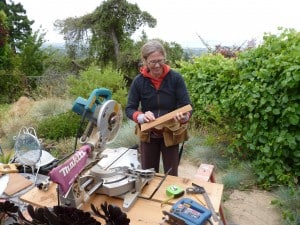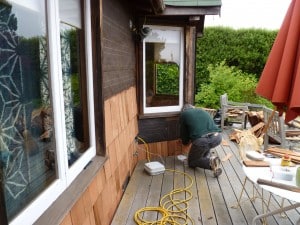Copywriters are good at finessing the connections among things to tell a story. They are not necessarily good at banging nails. But this copywriter has been banging nails for much of the last week, all the while musing on the hidden similarities between laying cedar shake siding and constructing excellent marketing prose.
Bear with me.

My family owns a little old brown-shingle cottage in the Berkeley Hills. It’s charming and chilly. It has its quirks. And never in its 95-year history, except when it was first built, have all its exterior walls been freshly shingled at the same time. As an addition was built, clad with fresh shingles, an old section was left behind with splintering shakes; as one exposure weathers, a different exposure is refreshed. Hence, we have never, ever, enjoyed a period without some side of the house in desperate need of reshingling.
We don’t live there anymore; we rent it out to a cellist who plays a lot of music festivals in the summer. We took advantage of her absence to move back in for a week, wax nostalgic about our old life, and try to save some serious money with DIY shingling. (Shingling pros are expensive, and it’s not a task to entrust to an odd-job guy.)

My husband knows carpentry, and had shingled part of the house ten or twelve years ago. I am not afraid of tools, power- or hand-, so I was game. He quickly taught me the basics. It’s much harder than I imagined.
It’s slow and painstaking and every little goof is compounded down the line. One shingle a bit off square means the next will be that much further out of whack. As I struggled with horizontals that meandered off the chalk line and angled joins that gapped to expose tar paper, I thought about how craftsmanship is craftsmanship, be it carpentry or copywriting. They both require:
Straight-edge precision. When laying shingles, you want the certainty of a spirit level bubble smack-dab where it belongs, so your edges line up straight and true. When writing copy, you want the clarity of a storyline that doesn’t get all convoluted and off topic, wandering into incoherence.

Tidy overlaps. Shingles are arranged in two layers, or courses, with the Number Two shakes underneath and the higher-quality Number One shakes on top. Widths vary, and you try to lay a fat shingle next to a thin shingle—but you can’t let the seam, or runnel, between one course run right into the runnel from the next course (or you create a little streambed for the rain). Trying to overlap them correctly becomes a Rubik’s Cube-style challenge as you advance along the wall. It’s not unlike trying to structure a piece of marcom copy so it moves briskly forward with snappy transitions and no redundancies. Or not so terribly unlike, I began to think after a few hours of shingling.
Tight corners. Stretches of flat wall are relatively easy to shingle. The devil’s in the corners, rooflines, beams, and angled window casements; if the shingles don’t quite meet up on corners and snug up to siding, the enemy—rain—will breach the gates. So it is with copywriting: get sloppy with the hard parts and pretty soon your white paper is full of holes.

Revisions. Here’s where copywriting and carpentry part ways: copywriting is greatly enhanced by revision. Revising something that has been sawn and nailed is never a good idea.
And what about that chiropractor? The “An X, a Y, and a Z walk into a bar” trope is always a triad. The chiropractor sounds right. And, needless to say, after a few days of shingle work, the copywriter/carpenter needs a chiropractor. And a drink.
There you go—a tidy piece of precision narrative craftsmanship. Watertight.


